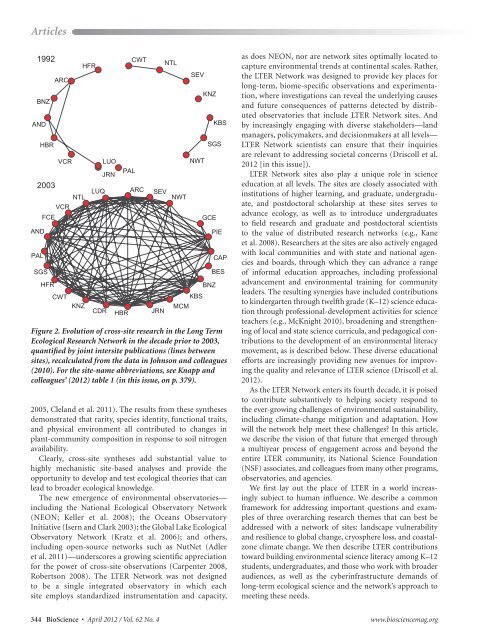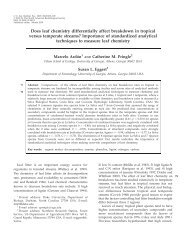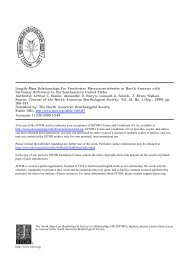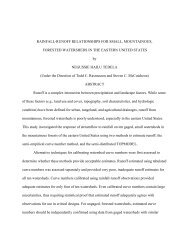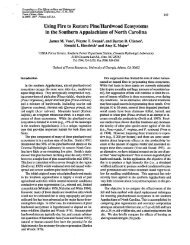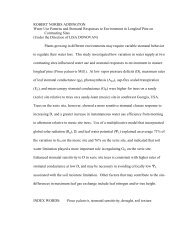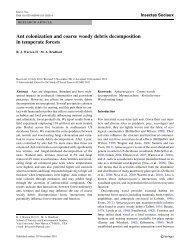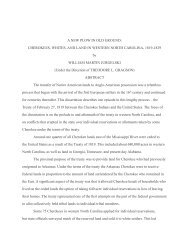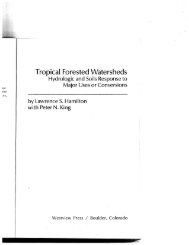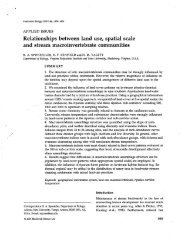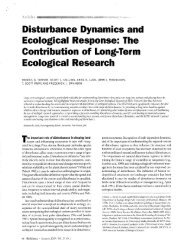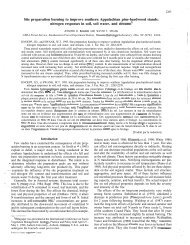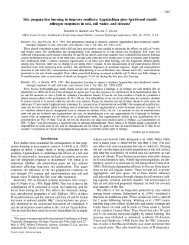biology join - Coweeta LTER - University of Georgia
biology join - Coweeta LTER - University of Georgia
biology join - Coweeta LTER - University of Georgia
Create successful ePaper yourself
Turn your PDF publications into a flip-book with our unique Google optimized e-Paper software.
Articles<br />
1992<br />
BNZ<br />
AND<br />
HBR<br />
2003<br />
AND<br />
PAL<br />
SGS<br />
FCE<br />
HFR<br />
ARC<br />
VCR LUO<br />
VCR<br />
CWT<br />
NTL<br />
KNZ<br />
HFR<br />
LUQ<br />
CDR<br />
JRN<br />
HBR<br />
PAL<br />
CWT<br />
ARC<br />
SEV<br />
JRN<br />
NTL<br />
NWT<br />
MCM<br />
SEV<br />
NWT<br />
KBS<br />
KNZ<br />
KBS<br />
SGS<br />
GCE<br />
BNZ<br />
PIE<br />
CAP<br />
BES<br />
Figure 2. Evolution <strong>of</strong> cross-site research in the Long Term<br />
Ecological Research Network in the decade prior to 2003,<br />
quantified by <strong>join</strong>t intersite publications (lines between<br />
sites), recalculated from the data in Johnson and colleagues<br />
(2010). For the site-name abbreviations, see Knapp and<br />
colleagues’ (2012) table 1 (in this issue, on p. 379).<br />
2005, Cleland et al. 2011). The results from these syntheses<br />
demonstrated that rarity, species identity, functional traits,<br />
and physical environment all contributed to changes in<br />
plant-community composition in response to soil nitrogen<br />
availability.<br />
Clearly, cross-site syntheses add substantial value to<br />
highly mechanistic site-based analyses and provide the<br />
opportunity to develop and test ecological theories that can<br />
lead to broader ecological knowledge.<br />
The new emergence <strong>of</strong> environmental observatories—<br />
including the National Ecological Observatory Network<br />
(NEON; Keller et al. 2008); the Oceans Observatory<br />
Initiative (Isern and Clark 2003); the Global Lake Ecological<br />
Observatory Network (Kratz et al. 2006); and others,<br />
including open-source networks such as NutNet (Adler<br />
et al. 2011)—underscores a growing scientific appreciation<br />
for the power <strong>of</strong> cross-site observations (Carpenter 2008,<br />
Robertson 2008). The <strong>LTER</strong> Network was not designed<br />
to be a single integrated observatory in which each<br />
site employs standardized instrumentation and capacity,<br />
as does NEON, nor are network sites optimally located to<br />
capture environmental trends at continental scales. Rather,<br />
the <strong>LTER</strong> Network was designed to provide key places for<br />
long-term, biome-specific observations and experimentation,<br />
where investigations can reveal the underlying causes<br />
and future consequences <strong>of</strong> patterns detected by distributed<br />
observatories that include <strong>LTER</strong> Network sites. And<br />
by increasingly engaging with diverse stakeholders—land<br />
managers, policymakers, and decisionmakers at all levels—<br />
<strong>LTER</strong> Network scientists can ensure that their inquiries<br />
are relevant to addressing societal concerns (Driscoll et al.<br />
2012 [in this issue]).<br />
<strong>LTER</strong> Network sites also play a unique role in science<br />
education at all levels. The sites are closely associated with<br />
institutions <strong>of</strong> higher learning, and graduate, undergraduate,<br />
and postdoctoral scholarship at these sites serves to<br />
advance ecology, as well as to introduce undergraduates<br />
to field research and graduate and postdoctoral scientists<br />
to the value <strong>of</strong> distributed research networks (e.g., Kane<br />
et al. 2008). Researchers at the sites are also actively engaged<br />
with local communities and with state and national agencies<br />
and boards, through which they can advance a range<br />
<strong>of</strong> informal education approaches, including pr<strong>of</strong>essional<br />
advancement and environmental training for community<br />
leaders. The resulting synergies have included contributions<br />
to kindergarten through twelfth grade (K–12) science education<br />
through pr<strong>of</strong>essional-development activities for science<br />
teachers (e.g., McKnight 2010), broadening and strengthening<br />
<strong>of</strong> local and state science curricula, and pedagogical contributions<br />
to the development <strong>of</strong> an environmental literacy<br />
movement, as is described below. These diverse educational<br />
efforts are increasingly providing new avenues for improving<br />
the quality and relevance <strong>of</strong> <strong>LTER</strong> science (Driscoll et al.<br />
2012).<br />
As the <strong>LTER</strong> Network enters its fourth decade, it is poised<br />
to contribute substantively to helping society respond to<br />
the ever-growing challenges <strong>of</strong> environmental sustainability,<br />
including climate-change mitigation and adaptation. How<br />
will the network help meet these challenges? In this article,<br />
we describe the vision <strong>of</strong> that future that emerged through<br />
a multiyear process <strong>of</strong> engagement across and beyond the<br />
entire <strong>LTER</strong> community, its National Science Foundation<br />
(NSF) associates, and colleagues from many other programs,<br />
observatories, and agencies.<br />
We first lay out the place <strong>of</strong> <strong>LTER</strong> in a world increasingly<br />
subject to human influence. We describe a common<br />
framework for addressing important questions and examples<br />
<strong>of</strong> three overarching research themes that can best be<br />
addressed with a network <strong>of</strong> sites: landscape vulnerability<br />
and resilience to global change, cryosphere loss, and coastalzone<br />
climate change. We then describe <strong>LTER</strong> contributions<br />
toward building environmental science literacy among K–12<br />
students, undergraduates, and those who work with broader<br />
audiences, as well as the cyberinfrastructure demands <strong>of</strong><br />
long-term ecological science and the network’s approach to<br />
meeting these needs.<br />
344 BioScience • April 2012 / Vol. 62 No. 4 www.biosciencemag.org


